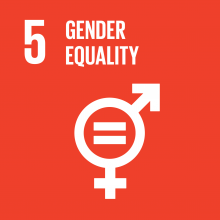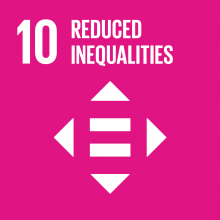The United Nations’ Sustainable Development Goals (SDGs) promise to “leave no one behind,” yet the framework is silent on specific issues faced by Lesbian, Gay, Bisexual, Transgender, Queer, Intersex, Asexual+ (LGBTQIA+) persons, and the LGBTQIA+ community is not specifically included in the SDG targets or indicators. While the international framework fails to directly mention LGBTQIA+ populations, local governments have the flexibility to localize the global goals to fit their own priorities and values. The City of Los Angeles is doing just that: adjusting language in the SDG targets and incorporating indicators to include the LGBTQIA+ community, ensuring truly equitable programs and policies that seek to leave no one behind.
In Summer 2020, The City of Los Angeles (LA) Mayor’s Office of International Affairs worked with a team of six students from the University of Southern California, the Thunderbird School of Global Management at Arizona State University, and Occidental College to draw on the best practices of other cities and new data sources to improve measures of impact, inclusion, and representation of LGBTQIA+ Angelenos in city services. Students worked under the guidance of faculty advisor Professor Sofia Gruskin (Institute on Inequalities in Global Health, University of Southern California).
City Case Studies
Our team began by identifying cities that have localized the SDGs and are leading the way on issues of LGBTQIA+ inclusion. Starting with a list of over fifty potential cities from which to learn, we narrowed our focus to a final list of seven. We chose to engage with these cities based on the following criteria:
- Cities that have completed a Voluntary Local Review of their progress toward the SDGs
- Cities that are part of an international network (e.g. Rainbow Cities or Ciudades Arcoiris)
- Cities that are internationally recognized for being LGBTQ-friendly by the Wellbeing Index
- Cities with robust data collection systems and performance indicators for LGBTQIA+ inclusivity
- Cities with strong LGBTQIA+ programming (e.g. Casa Trans in Buenos Aires)
- Cities with programs or structures that can be replicated in Los Angeles
- Cities with existing LGBTQIA+ governance structures (e.g. dedicated commission, office or staff)
- Cities with pre-existing relationships with the LA Mayor’s Office of International Affairs
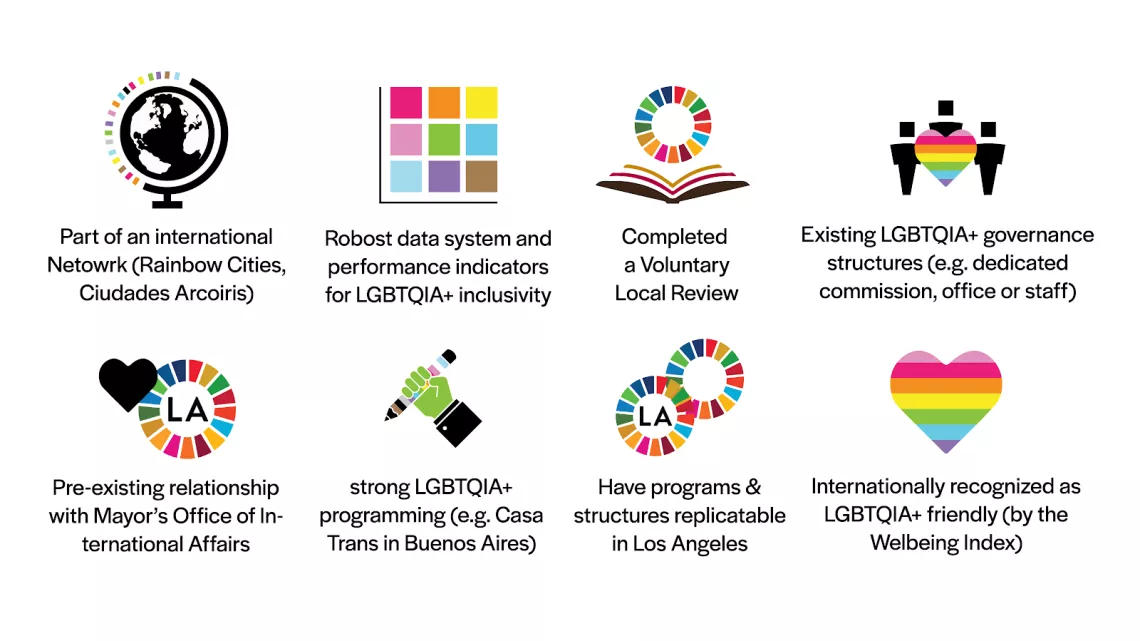
The final seven cities were Barcelona, Buenos Aires, Mannheim, Mexico City, New York City, São Paulo, and Seattle. While not all cities met all these criteria, they are on the vanguard of international efforts to include and support the LGBTQIA+ community. We were successful in contacting and interviewing government representatives in six cities within our 10 weeks of effort, missing only São Paulo. The city interviews were instrumental in identifying six key best practices for LGBTQIA+ inclusivity in city services, which we also present as recommendations for the City of LA. They are, as follows:
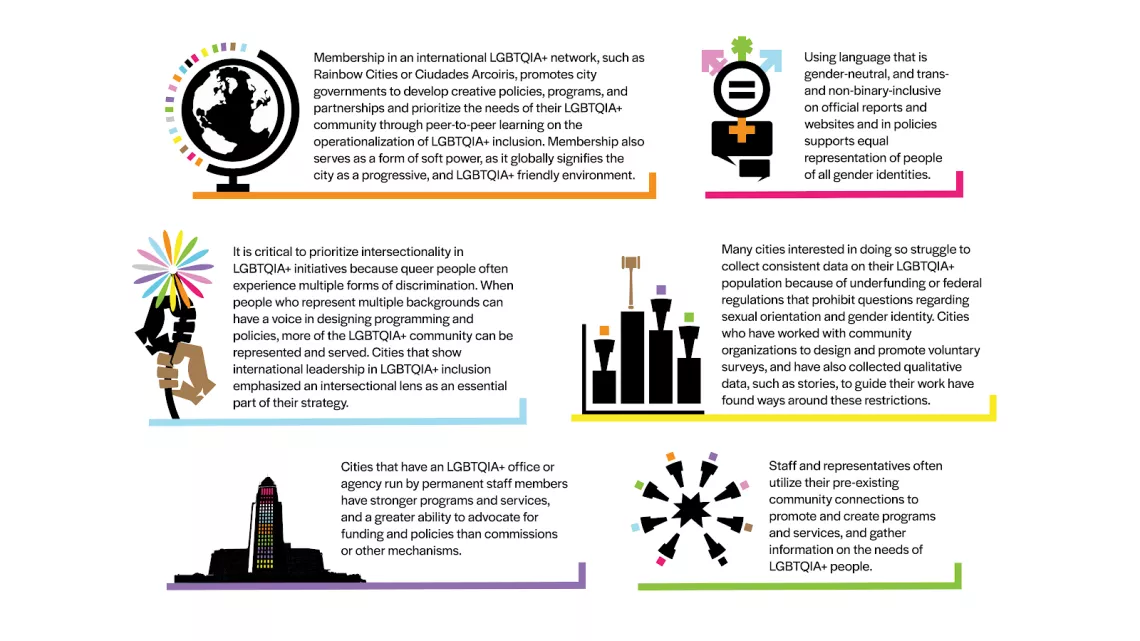
- Membership in an international LGBTQIA+ network, such as Rainbow Cities or Ciudades Arcoiris, promotes city governments to develop creative policies, programs, and partnerships and prioritize the needs of their LGBTQIA+ community through peer-to-peer learning on the operationalization of LGBTQIA+ inclusion. Membership also serves as a form of soft power, as it globally signifies the city as a progressive, and LGBTQIA+-friendly environment.
- It is critical to prioritize intersectionality in LGBTQIA+ initiatives because queer people often experience multiple forms of discrimination. When people who represent multiple backgrounds can have a voice in designing programming and policies, more of the LGBTQIA+ community can be represented and served. Cities that show international leadership in LGBTQIA+ inclusion emphasized an intersectional lens as an essential part of their strategy.
- Cities that have an LGBTQIA+ office or agency run by permanent staff members have stronger programs and services, and a greater ability to advocate for funding and policies than commissions or other mechanisms.
- Staff and representatives often utilize their pre-existing community connections to promote and create programs and services, and gather information on the needs of LGBTQIA+ people.
- Using language that is gender-neutral, and trans- and non-binary-inclusive on official reports and websites and in policies supports equal representation of people of all gender identities.
- Many cities interested in doing so struggle to collect consistent data on their LGBTQIA+ population because of underfunding or federal regulations that prohibit questions regarding sexual orientation and gender identity. Cities who have worked with community organizations to design and promote voluntary surveys, and have also collected qualitative data, such as stories, to guide their work have found ways around these restrictions.
Data Disaggregation
Building on our key findings, we worked to identify disaggregated data sources for the City of Los Angeles to use to measure LGBTQIA+ inclusivity in the localized SDG framework. Before this project, the localized Los Angeles Sustainable Development Goals framework included four new indicators that measure LGBTQIA+ inclusivity and representation and one existing indicator that was disaggregated by sexual orientation and gender identity:
- 5.x.1 and 10.x.1: Whether or not legal frameworks are in place to promote, enforce and monitor equality and non‐discrimination on the basis of sexual orientation and gender identity
- 10.x.2: Proportion of students who feel that LGBTQ students are accepted at their school.
- 10.x.3: Whether or not there are centralized protocols for updating sex/gender in official certifications
- 11.1.1: Proportion of of urban population living in slums, informal settlements or inadequate housing (disaggregated by sexual orientation and gender identity)
These indicators demonstrate the City’s commitment to ensuring that all Angelenos, especially the LGBTQIA+ community, are not left behind. Creating additional indicators to understand the experience of the LGBTQIA+ community in Los Angeles and disaggregating current indicators for LGBTQIA+ can strengthen the City’s ability to better address the needs of LGBTQIA+ Angelenos. At this time, the team proposes 20 additional indicators (tabulated below) for the City to incorporate into the SDG framework. This final list of indicator disaggregations was identified based on the following criteria:
- Indicator is quantitative, statistical, and measures human data
- Indicator measures an outcome that is relevant to LGBTQIA+ (via literature review)
- A data source is available that can provide a disaggregation
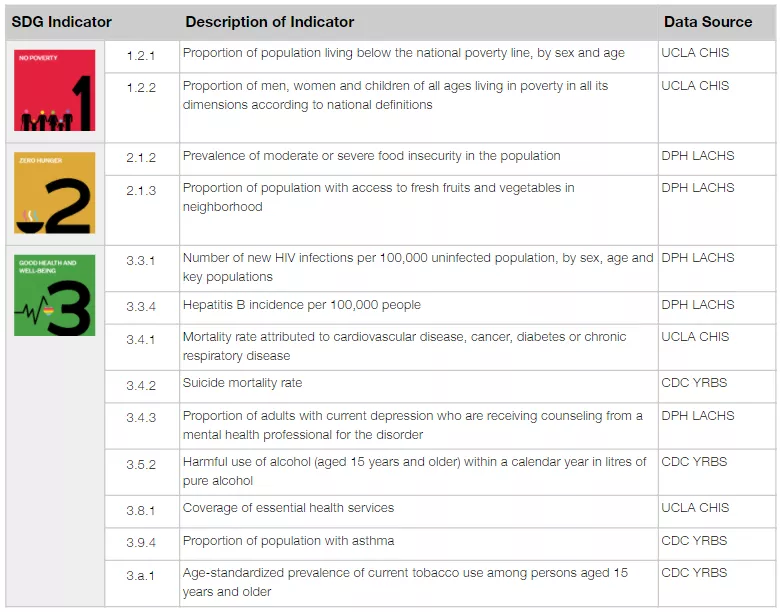
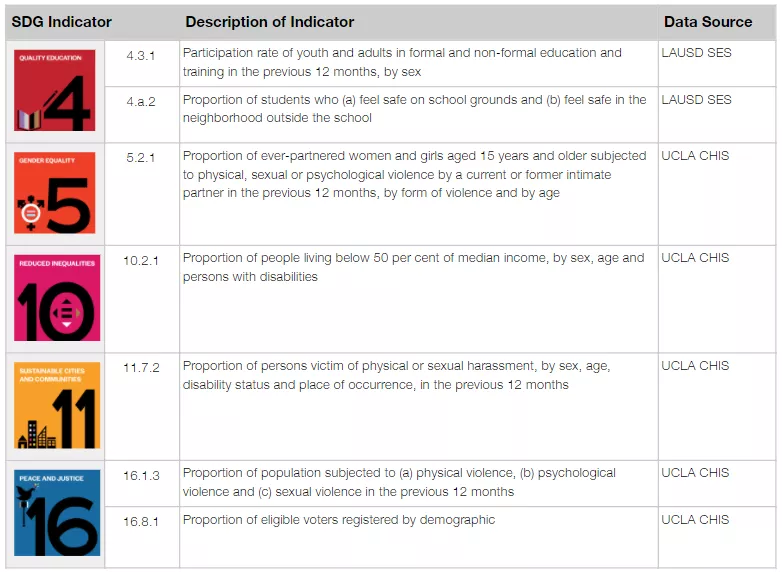
Future Study
As the City of Los Angeles looks to the future, the team recommends the following points for future study:
- Consider the current responsibilities and purview of the Gender Equity Office, and expand its mission to include a more inclusive understanding of gender and its subsequent impact on trans and non-binary communities.
- Continue communication and collaboration with Interview Case Studies cities to determine best practices and collective efforts on LGBTQIA+ inclusion.
- Conduct further research of the LGBTQIA+ initiatives, and consider conducting interviews, with the following cities: Amsterdam, Berlin, Brussels, London, Pittsburgh, Rotterdam, San Francisco, Tel Aviv, and Toronto.
- Re-examine Voluntary Local Review city programs and data collection practices to determine whether progress has been made on LGBTQIA+ inclusion. LGBTQIA+ initiatives in emerging VLR cities should also be analyzed. Specific examination should be given to Buenos Aires’ data collection and programs for SDG 5 (Gender Equality).
- Join an international LGBTQIA+ city network, potentially Rainbow Cities or Red Latinoamericana de Ciudades Arcoiris. Additionally, continue fostering connections with the connections with the LGBTQIA+ initiatives in other US cities such as in other US cities such as Seattle, New York City, and Pittsburgh.
- Develop forums with civil society organizations similar to the ones exposed in the City Case Studies section, to involve the voices of LGBTQIA+ Angelenos in the development of programs and policies. Additionally, collect data from forum participants through voluntary surveys.
- Recognizing the importance of intersectionality in Los Angeles’ future LGBTQIA+ mission, a specific emphasis must be placed on racial equity within the initiative.
